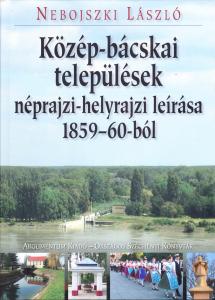
Ethnographical and topographical description of Middle-Bácska settlements from 1859–60
Ethnographical and topographical description of Middle-Bácska settlements from 1859–60
Written By László Nebojszki
NSZL – Argumentum Publishing House, Budapest, 2021., 932+24 pages
ISBN 978 963 446 826 4
Count Johann Coronini-Cronberg, the military and civil governor of the Serbian Vojvodina and Banat of Temes, ordered the local and ethnographic description of the settlements in an order dated 8 January 1859, with the help of leaders and intellectuals who were well acquainted with the local conditions of the various subjects. He fixed July 1859 as the deadline for submissions, and the end of February of the following year for works requiring all-year observation. The descriptions received in Temesvár (Timișoara), which in some cases could be regarded as small monographs, were forwarded to Henrik Kümmer, the provincial schools inspector, who later handed them over to Zsigmond Ormós, the chief notary of Temes (Timiș) County (and county government commissioner between 1867 and 1871). From him and through him they were transferred in 1872 to the South Hungarian Historical and Archaeological Museum Society founded in Temesvár. The members of the Bács-Bodrog County Historical Society, founded in Zombor (Sombor) in 1883, attempted to obtain the complete material in the early 1900s, but their colleagues in Timisoara, citing their regulations, offered only the possibility of studying it on the spot.
After the First World War, Timisoara was annexed to Romania, and the works are currently available at the State Archives of Timis County. In the 1970s, Professor Antal Scherer from Graz had photocopies made of them, at the same time microfilm copies were sent to the Archives of Vojvodina, and finally, in 1981, a copy was sent to Budapest in the framework of an exchange.
This hard-to-access, German but Gothic-lettered, handwritten text difficult to read and interpret, and the spelling and writing that varies from settlement to settlement have so far led many Germans who were displaced after the Second World War to work on a description or a detail of a description of their former settlements while preparing a monograph of their homeland. Little is known of this important material by those who study Hungarian ethnography and local history. The processing of the works on the settlements of Middle-Bácska adds important data to our knowledge of the period and the landscape in relation to the conditions prevailing in the middle of the 19th century.
In this publication we undertake to publish the works studied in Temesvár in both languages, with the necessary additions and studies. It should be noted here that the Gothic script (Fraktur) has been transcribed with accuracy in mind, while the Hungarian translation has been prepared with a view to making it readable and comprehensible. It is clear from the revived past that the people of Bácska contributed to the economic and social development of Hungary.
Shopping
Our publications are available in our bookshop, or can be ordered from the Publications Department of the NSZL using the contact details below: Főigazgatói Kabinet kiadványtára, Országos Széchényi Könyvtár, 1276 Budapest P.O. box 1205., phone: 06-1-23-23-506, e-mail: kiadvanytar@oszk.hu.




